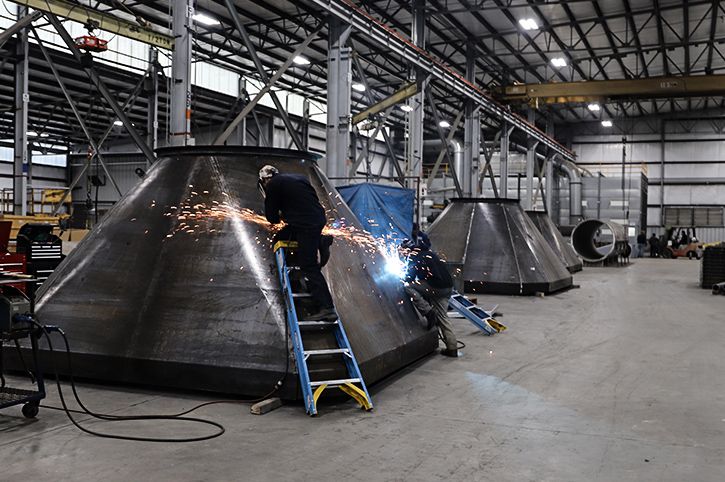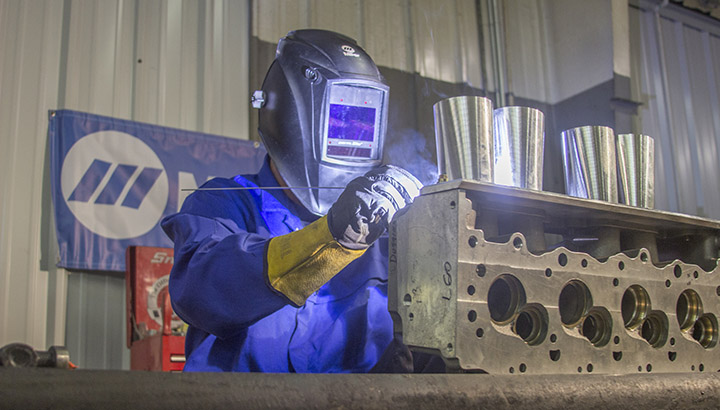Fixing cracking in welded joints: tips from Montana Mobile Welding and Repair Fabrication
Wiki Article
Typical Welding Repair Issues and How to Address Them Effectively
Welding repairs frequently experience a series of concerns that can jeopardize the integrity of the end product. Usual issues include poor penetration, porosity, and imbalance, to name a few. Each issue presents special difficulties that need details methods for resolution. Comprehending these concerns is necessary for welders aiming to improve their abilities and end results. This conversation will check out these usual welding repair service issues and reliable approaches to resolve them.Insufficient Infiltration
Inadequate penetration takes place when the weld metal fails to completely fuse with the base material, leading to weak joints and prospective structural failings. This issue commonly originates from insufficient warm input, incorrect electrode angle, or improper welding rate. Welders might experience insufficient infiltration because of a mistake of the necessary specifications for a particular material thickness or kind. Additionally, contamination on the base material's surface can hinder efficient bonding, aggravating the trouble. To address insufficient infiltration, welders ought to guarantee proper settings on their equipment and maintain a tidy work surface area. Routine inspection of welds is advised to recognize any shortages early, permitting timely improvements and the prevention of jeopardized structural honesty in bonded assemblies.Porosity
Porosity is a common problem in bonded joints that materializes as small gas bubbles trapped within the weld metal. This flaw can compromise the integrity of the weld, bring about lowered toughness and possible failing under tension. Fabrication. Porosity commonly emerges from contamination, moisture, or improper welding strategies, which enable gases to run away right into the liquified weld pool. To attend to porosity, welders need to ensure correct surface prep work, keep a clean functioning atmosphere, and utilize appropriate welding parameters. Furthermore, picking the best filler product and protecting gas can alleviate gas entrapment. Routine assessment and testing of welds can help identify porosity early, assuring timely corrective actions are taken, therefore preserving the high quality and dependability of the bonded structureImbalance
Misalignment in welding can emerge from numerous factors, consisting of incorrect setup and thermal development. Understanding the source is important for efficient resolution. A number of improvement techniques are offered to realign parts and assure architectural integrity.Root causes of Misalignment
Welding misalignment often comes from a variety of underlying concerns that can endanger architectural stability. One main cause is improper fit-up of parts before welding, which can cause gaps and uneven surface areas. Variants in thermal development during the welding procedure can also cause distortion, particularly if the materials being joined have different coefficients of growth. Additionally, insufficient clamping and fixturing might fail to hold parts safely in area, resulting in motion throughout welding. Poorly kept tools, consisting of welding equipments and tools, might introduce variances in the weld grain, further adding to imbalance. Ultimately, operator mistake, originating from not enough training or experience, can also play a substantial duty in creating misaligned welds.Adjustment Methods Readily Available
Addressing imbalance effectively calls for a mix of rehabilitative strategies customized to the details concerns available. One common approach is the use of jigs or fixtures to hold elements in the correct position during welding, guaranteeing constant positioning. Furthermore, preheating the materials can help in reducing distortion and improve fit-up. For considerable imbalance, mechanical adjustment methods, such as using hydraulic jacks or clamps, can be used to deal with the placement before welding. Post-weld warm treatment may likewise be required to soothe stresses brought on by imbalance. Careful assessment and adjustment during the setup phase can protect against imbalance concerns from becoming substantial troubles, promoting a smoother welding process and improving total structural integrity.Distortion
Distortion is a typical difficulty in welding that can develop from various aspects, consisting of irregular heating and air conditioning. Comprehending the sources of distortion is essential for executing reliable prevention methods. Addressing this concern not just enhances structural stability yet also improves the overall top quality of the weld.Sources of Distortion
When subjected to the intense warm of welding, products typically go through modifications that can cause distortion. This phenomenon mainly develops from thermal growth and tightening during the welding process. As the weld location warms up, the product increases; upon air conditioning, it contracts, which can produce internal stress and anxieties. Furthermore, irregular home heating across a workpiece can worsen these tensions, leading to bending or bending. The sort of material likewise plays a considerable function; metals with differing thermal conductivity and coefficients of growth may respond in a different way, bring about unforeseeable distortions. Bad joint design and insufficient fixturing can add to misalignment during welding, raising the likelihood of distortion. Recognizing these causes is essential for effective welding repair service and avoidance strategies.Avoidance Techniques
Effective avoidance methods for distortion throughout welding focus on managing warm input and making sure proper joint design. Keeping a regular heat input aids to minimize thermal growth and tightening, which can cause distortion. Utilizing strategies such as pre-heating the work surface can also decrease the temperature slope, advertising consistent heating. In addition, selecting ideal joint styles, such as T-joints or lap joints, can boost security and minimize stress focus. Applying proper fixturing to protect the workpieces in position even more aids in maintaining positioning during the welding process. Staggered welding series can disperse warmth much more evenly, avoiding local distortion. By applying these methods, welders can greatly lower the probability of distortion and enhance the overall top quality of their welds.Breaking
Cracking is a common issue encountered in welding fixings, commonly arising from various factors such as improper air conditioning prices, material option, or inadequate joint preparation. The incident of splits can greatly jeopardize the honesty of the weld, bring about possible failures throughout operation. To address this problem, welders have to first examine the origin creates, guaranteeing that products work and properly selected for the certain application. In addition, regulating the air conditioning price throughout the welding procedure is necessary; rapid air conditioning can generate tension and bring about sip welders splitting. Appropriate joint style and prep work additionally add to decreasing the danger. Implementing these techniques can boost weld quality and resilience, inevitably reducing the likelihood of splitting in completed weldments.
Incomplete Combination
A considerable concern in welding repair services is incomplete blend, which happens when the weld steel does not effectively bond with the base product or previous weld passes - Montana Mobile Welding and Repair Belgrade Fabrication. This flaw can lead to weak points in the joint, possibly endangering the integrity of the welded framework. Aspects adding to incomplete blend include insufficient warmth input, improper welding technique, and contamination of the surfaces being joined. To address this issue efficiently, welders ought to best welder for beginners ensure proper pre-weld cleaning and surface preparation, in addition to readjust their welding parameters to attain appropriate infiltration and fusion. Regular inspection during the welding process can also aid determine insufficient combination early, enabling timely restorative measures to boost the total top quality of the weldOverheating
While welding repair services can improve architectural honesty, overheating presents a considerable difficulty that can cause material deterioration. Too much warm during welding can change the mechanical homes of metals, causing lowered strength, enhanced brittleness, and warping. This phenomenon is especially critical in high-stress applications where architectural reliability is vital. Determining overheating can include aesthetic evaluations for discoloration or distortion, as well as monitoring temperature level throughout the welding procedure. To minimize the risks linked with getting too hot, welders need to employ suitable techniques, such as regulating warmth input, changing travel speed, and utilizing appropriate filler materials. In addition, implementing pre- and post-weld heat therapies can help recover product residential or commercial properties and boost the overall high quality of the repair work, ensuring long-term performance and safety and security.Frequently Asked Inquiries
What Are the Usual Signs of a Welding Issue?

Just How Can I Evaluate My Welds for High quality?
To evaluate welds for quality, one can utilize visual assessments, ultrasonic testing, and radiographic techniques. Each technique guarantees structural integrity, determines flaws, and confirms adherence to defined standards, ultimately enhancing the reliability of the welded joints.What Security Safety Measures Should I Take While Welding?
When welding, one need to prioritize security by using appropriate individual protective devices, making certain appropriate air flow, protecting flammable materials away, maintaining a clean workspace, and recognizing environments to prevent accidents and injuries.Can I Repair a Weld Without Redesigning the Entire Joint?
Fixing a weld without redesigning the entire joint is possible, discover this info here depending on the damage (Montana Mobile Welding and Repair Welding). Strategies such as grinding, including filler product, or utilizing a welding process can successfully address particular problems while maintaining the surrounding structureWhat Tools Are Crucial for Reliable Welding Services?
Necessary tools for reliable welding fixings include a welding maker, wire brush, grinder, protective gear, clamps, and filler products. Each device plays a vital function in guaranteeing high quality and security throughout the fixing process. Porosity typically develops from contamination, wetness, or incorrect welding methods, which allow gases to escape into the liquified weld pool. Badly maintained equipment, including welding machines and tools, might introduce disparities in the weld bead, further adding to imbalance. When subjected to the extreme warm of welding, products usually go through adjustments that can lead to distortion. Breaking is a typical problem come across in welding fixings, usually resulting from various aspects such as inappropriate cooling prices, material selection, or poor joint preparation. A considerable issue in welding repair services is insufficient blend, which happens when the weld steel does not sufficiently bond with the base material or previous weld passes.Report this wiki page